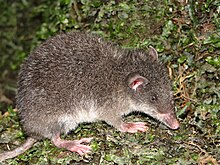Shrew opossum
| Shrew opossums | |
|---|---|

| |
Caenolestes sangay
| |
| Scientific classification | |
| Domain: | Eukaryota |
| Kingdom: | Animalia |
| Phylum: | Chordata |
| Class: | Mammalia |
| Infraclass: | Marsupialia |
| Order: | Paucituberculata |
| Family: | Caenolestidae Trouessart, 1898 |
| Type genus | |
| Caenolestes Thomas, 1895
| |
| Genera | |
| |

| |
| Synonyms | |
| |
The
Shrews were entirely absent from South America until the
Shrew opossums (also known as rat opossums or caenolestids) are about the size of a small rat (9–14 cm long), with thin limbs, a long, pointed snout and a slender, hairy tail. They are largely carnivorous, being active hunters of
Largely because of their rugged, inaccessible habitat, they are very poorly known and have traditionally been considered rare. Several ecological factors, including density of forest, contribute to the part of the forests the shrew opossums occupy. Recent studies suggest they may be more common than had been thought. Their karyotype has also been described through contemporary research in order to better understand this organism.[5]
Classification
| Cladogram of living Caenolestidae[6][7] | Cladogram of extinct Caenolestidae[8] | ||||||||||||||||||||||||||||||||||||||||||||||||||||||||||||||||||||||||||||||
|---|---|---|---|---|---|---|---|---|---|---|---|---|---|---|---|---|---|---|---|---|---|---|---|---|---|---|---|---|---|---|---|---|---|---|---|---|---|---|---|---|---|---|---|---|---|---|---|---|---|---|---|---|---|---|---|---|---|---|---|---|---|---|---|---|---|---|---|---|---|---|---|---|---|---|---|---|---|---|---|
|
|
- Genus Caenolestes Thomas 1895
- C. caniventer (Gray-bellied caenolestid)
- C. condorensis (Andean caenolestid)
- C. convelatus (Northern caenolestid)
- C. fuliginosus (Dusky caenolestid)
- C. sangay[9] (Eastern caenolestid)
- Genus †Caenolestoides Arbello, Martin & Cardoso 2021
- †C. miocaenicus Arbello, Martin & Cardoso 2021
- Genus †Gaimanlestes Arbello, Martin & Cardoso 2021
- †G. pascuali Arbello, Martin & Cardoso 2021
- Genus LestorosOehser 1934
- L. inca (Peruvian or Incan caenolestid)
- Genus †Pliolestes Reig 1955
- †P. tripotamicus Reig 1955
- †P. venetus Goin, Montalvo & Visconti 2000
- Genus †Pseudhalmarhiphus Ameghino 1903
- †P. guaraniticus (Ameghino 1899) Ameghino 1903
- Genus RhyncholestesOsgood 1924
- R. raphanurus (Long-nosed caenolestid)
- Genus †Stilotherium Ameghino 1887
- †S. parvum Arbello, Martin & Cardoso 2021
- †S. dissimile Ameghino 1887
However, Bublitz[citation needed] suggested in 1987 there were actually two Lestoros and Rhyncholestes species (those listed here plus L. gracilis and R. continentalis). This is, however, not accepted by most scientists.[citation needed]
Fossils
Spatio-temporal locations of fossil species:[10]
Paleogene
- Eocene
- Perulestes - Pozo Formation, Peru
- Barrancan
- Progarzonia notostylopense - Sarmiento Formation, Argentina
- Pseudhalmarhiphus guaraniticus - Sarmiento Formation, Argentina
Neogene
- Pebas Formation, Amazon Basin
- Caenolestoides miocaenicus - Sarmiento Formation, Colhue-Huapi Member[8]
- Gaimanlestes pascuali - Sarmiento Formation, Trelew Member[8]
- Stilotherium parvum - Sarmiento Formation, Colhue-Huapi Member[8]
- Honda Group, Bolivia
- Pliolestes venetus - Cerro Azul Formation, Argentina
- Pliocene
- Umala Formation, Bolivia
- Pliolestes tripotamicus - Argentina
See also
References
- OCLC 62265494.
- ^ PMID 20668664.
- JSTOR 1382707.
- ^ Patterson (2008), page 126
- JSTOR 1381695.
- PMC 6892540.
- .
- ^ .
- .
- ^ Caenolestidae at Fossilworks.org
